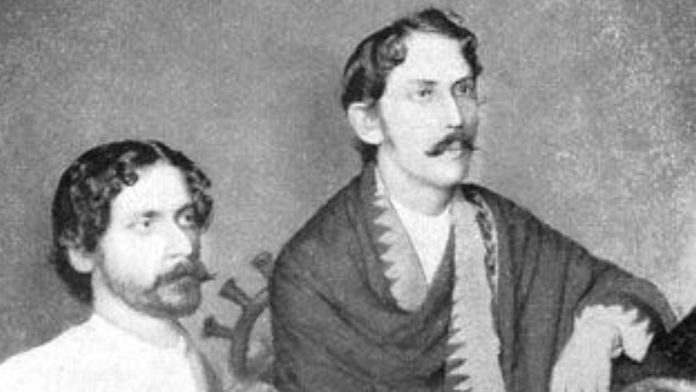The year was 1870. In Kolkata’s Jorasanko, two brothers were writing songs and composing music on the piano. The older brother used music to give shape to his thoughts, while the other wove words to the pieces they were composing. Unknown to the world, these brothers were shaping the cultural landscape of Bengal.
Jyotirindranath Tagore was a respected playwright, musician and painter in his own right. However, he was always eclipsed by his younger brother, Rabindranath Tagore, who went on to become one of India’s most prominent literary figures.
Born to an aristocratic family, often addressed as the Thakurbari, it was Jyotirindranath who recognised his younger brother ‘Robi’s’ talent and gave him the wings to soar. Jyotirindranath actively encouraged Rabindranath to explore his passions in music, dance, and theatre.
A paper on his life, published in the International Journal of Research, suggests that Jyotirindranath never got his due recognition as a playwright, even though he was among the pioneers of Bengali theatre such as Girish Chandra Ghosh and Dwijendralal Roy.
Relegated to just a few pages in history books, he is the brother that time forgot.
Overshadowed, forgotten
Jyotirindranath Tagore was a composer, a playwright, a doting brother and a progressive husband. But one aspect of his life overshadowed the others–his wife Kadambari’s relationship with Rabindranath Tagore.
Kadambari was nine when she entered the Tagore household as the bride of Jyotirindranath, who was 10 years her senior. Rabindranath, however, was seven, which allowed the two to quickly become firm friends. But rumours and speculation about their relationship only grew over the years, especially as she became Rabindranath’s muse.
Jyotirindranath never really escaped the shadow of their relationship. However, various records state that he was an exceptionally innovative thinker, who encouraged his wife to defy the traditional roles accorded to women. He advocated for his bride to be educated in Western languages and allowed her to pursue ‘unorthodox’ hobbies like horseback riding.
When Kadambari died by suicide four months after Rabindranath’s marriage, Jyotirindranath left his house to live as a recluse in Ranchi, Jharkhand. His niece Indira Debi had once said that the only decoration in his Ranchi home was a pencil drawing by ‘Notun Kakima’ (Kadambari Devi).
Also read:
A committed nationalist, bold playwright
Jyotirindranath forayed into the world of theatre with thrilling plays that he meticulously crafted to instil a profound sense of national pride in people. He was one of the main proponents of the Swadeshi movement.
A committed nationalist, he was also involved with a secret society called Sanjivani Sabha. A deeply covert organisation, the sabha conducted all communications in code, “perhaps because its goal was to awaken nationalism”, reads Bhaswati Chakravorty’s article in The Telegraph. One task of this society was creating pan-Indian attire, which Jyotirindranath led. He created a combination of pyjamas and dhoti, and headgear that merged a turban with a sola hat. “He alone among the members of the committee — which included the youthful Rabindranath — had the temerity to wear this in public,” writes Chakravorty.
Jyotirindranath’s dramas were rooted in Indian history and infused with nationalist themes. Additionally, he translated classical and contemporary works from French, Marathi, and Sanskrit, showcasing his linguistic prowess.
The Jorasanko Theatre, located in the Tagore’s ancestral residence, witnessed Jyotirindranath’s captivating writing come to life. He performed on this stage too, boldly taking on female roles. An embarrassed British man once ran away from the green room behind the Jorasanko stage, muttering, “Zenana! Zenana!” as he encountered Jyotirindranath, who was dressed as a nati (danseuse).
Honesty was crucial to Jyotirindranath’s creative vision as a playwright. In one instance, he removed plants to make way for a woodland scene with real glowworms. In another, he captured real egrets to represent birds in a play.
Jyotirindranath’s artistic palate also included music—he could play the sitar, piano, violin, and harmonium. His versatility extended to the visual arts, too. His artistic journey began with portraits drawn during his school days, evolving exceptionally as he grew up.
Jyotirindranath nurtured young Robi’s artistic spirit, guiding him in music composition, poetic metre, and musical notation. However, as Rabindranath’s star ascended, Jyotirindranath’s brilliance faded.
Jyotirindranath was a romantic in expression and a classicist in technique, his legacy a fusion of contrasting elements.
His last home, Tagore Hill, came up in the news in September 2023, when the Jharkhand High Court directed authorities to beautify the scenic place.
The petitioner for the case cited the Bengali book Jyotirindranather Jiban-Smriti (The Life and Times of Jyotirindranath Tagore), written by Vasantakumar Chattopadhyay and published in 1920. The petitioner noted that Jyotirindranath had made an entry in his diary on 23 October 1908, stating that “today the hill is registered.” Subsequently, the house named ‘Shanti Dham’ was constructed on this hill and inaugurated in 1910.
Jyotirindranath died there on 4 March 1925.
(Edited by Zoya Bhatti)



